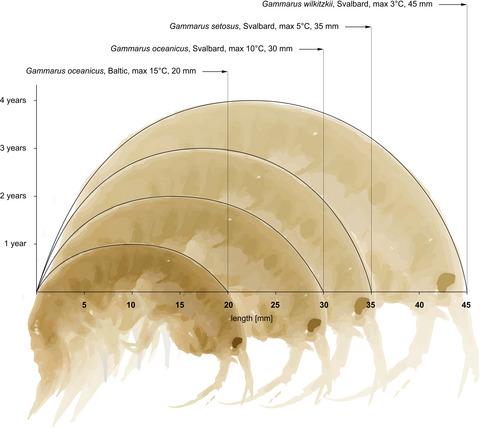当前位置:
X-MOL 学术
›
Ecol. Evol.
›
论文详情
Our official English website, www.x-mol.net, welcomes your feedback! (Note: you will need to create a separate account there.)
Will shrinking body size and increasing species diversity of crustaceans follow the warming of the Arctic littoral?
Ecology and Evolution ( IF 2.6 ) Pub Date : 2020-09-22 , DOI: 10.1002/ece3.6780 Jan M. Węsławski 1 , Joanna Legeżyńska 1 , Maria Włodarska‐Kowalczuk 1
Ecology and Evolution ( IF 2.6 ) Pub Date : 2020-09-22 , DOI: 10.1002/ece3.6780 Jan M. Węsławski 1 , Joanna Legeżyńska 1 , Maria Włodarska‐Kowalczuk 1
Affiliation

|
Over thirty species of littoral marine Gammaridea occur along the coasts of the North Atlantic. From one to several species can coexist in a single region. There is an evident, inverse relationship between egg incubation time and temperature (from 14 to >120 days) and consequent trends in the size of the animals on reaching maturity (from 5 mm in warmer waters to 30 mm in the coldest ones) and in lifespan (from <6 months to >5 years). Littoral gammarids are a good example of the shrinking size effect of increasing temperatures and size‐related species diversity. In large species, the annual cohorts of the population (3–5 annual size groups) functionally replace the adults of smaller species. The ongoing warming of the European Arctic seas may extend the distribution limits of boreal species so that more Gammarus species may appear on northern coasts hitherto occupied by just one or at most two species.
中文翻译:

北极沿海的变暖会导致甲壳动物的体型缩小和物种多样性增加吗?
北大西洋沿岸有三十多种沿海海洋Gammaridea物种。在一个区域中可以同时存在一种到几种物种。卵的孵化时间和温度(从14天到> 120天)与成年后的动物大小趋势(从较温暖的水域中的5毫米到最冷的水域中的30毫米)和在孵化中的动物之间的趋势呈明显的反比关系。寿命(从<6个月到> 5年)。沿岸的γ-角膜炎是温度升高和与尺寸有关的物种多样性不断缩小的规模效应的一个很好的例子。在大型物种中,种群的年度队列(每年3至5个年龄组)在功能上替代了较小物种的成年种群。欧洲北极海的持续变暖可能会扩大北方物种的分布范围,从而使更多的伽玛鲁斯 迄今为止可能仅在一种或至多两种物种所占据的北部海岸出现该物种。
更新日期:2020-10-12
中文翻译:

北极沿海的变暖会导致甲壳动物的体型缩小和物种多样性增加吗?
北大西洋沿岸有三十多种沿海海洋Gammaridea物种。在一个区域中可以同时存在一种到几种物种。卵的孵化时间和温度(从14天到> 120天)与成年后的动物大小趋势(从较温暖的水域中的5毫米到最冷的水域中的30毫米)和在孵化中的动物之间的趋势呈明显的反比关系。寿命(从<6个月到> 5年)。沿岸的γ-角膜炎是温度升高和与尺寸有关的物种多样性不断缩小的规模效应的一个很好的例子。在大型物种中,种群的年度队列(每年3至5个年龄组)在功能上替代了较小物种的成年种群。欧洲北极海的持续变暖可能会扩大北方物种的分布范围,从而使更多的伽玛鲁斯 迄今为止可能仅在一种或至多两种物种所占据的北部海岸出现该物种。


























 京公网安备 11010802027423号
京公网安备 11010802027423号